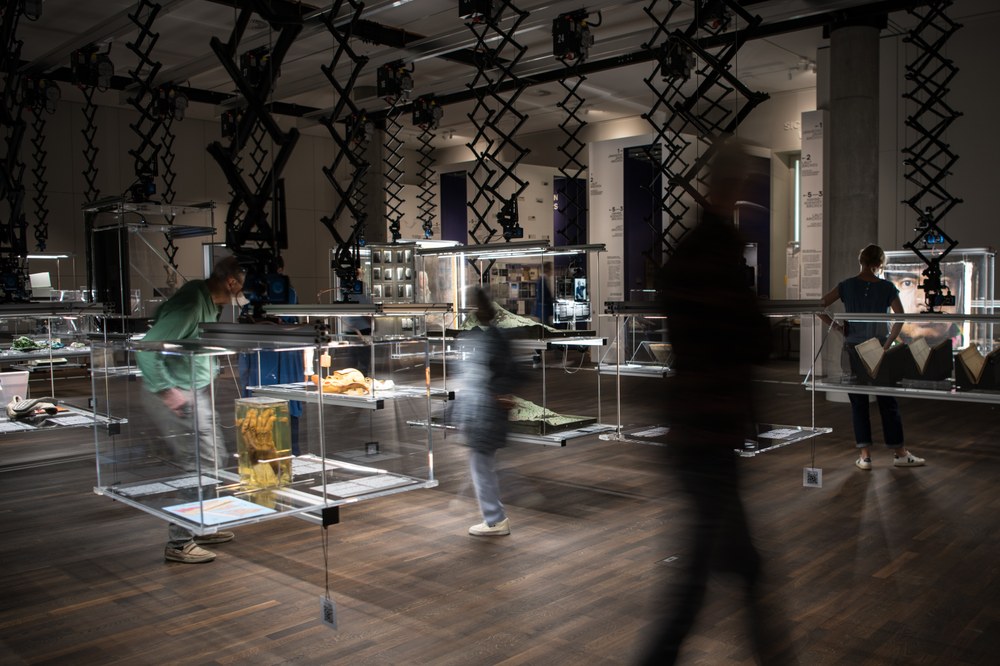Collective intelligence and clusters of excellence

Stiftung Humboldt Forum im Berliner Schloss / Stefanie Loos
What does a school of ornamental fish have to do with modern science? You might find yourself wondering, upon entering the 'After Nature' exhibition at the Humboldt Lab, inside the new Berlin Palace. Guppies are displayed on the huge projection screen that diagonally divides the entrance hall. If danger threatens, they rearrange themselves in an instant and simultaneously change their swimming direction. This ability to act like a complex single organism is a powerful image for modern research, which turns to interconnectedness across disciplines in its efforts to address the most pressing challenges of the modern age.
The Humboldt Lab is a part of the Humboldt Forum, alongside the collections of the Ethnological Museum and the Museum of Asian Art. It was recently built on the site of the former Palace of the Republic. Exhibits on human medicine, climate research, information technology and sociology are displayed across an area of approximately 500 square metres. They address several fundamental questions: How have humans shaped the world since the beginning of the industrial age? What problems has this caused? And how can science contribute towards solving them? The Lab focuses on research projects by scientists from the Humboldt University of Berlin and the clusters of excellence across the capital in which they are embedded.
From Humboldt to brain research
The exhibition begins with several screen exhibits that connect pioneering eighteenth-century researchers Alexander and Wilhelm von Humboldt to present-day projects involving current researchers from Humboldt University. They cover subjects including the detection and treatment of neurological diseases using a new kind of miniaturised magnetic resonance imaging (MRI) machine. Unlike a classic MRI, this device allows patients to make various movements, such as with their hands, during a brain scan. When a patient is unable to carry out a movement as instructed, the area of the brain that should have activated but instead remained passive can be pinpointed. If surgery is required, a highly accurate projection onto the exposed brain can be used to highlight this area. The similarities between a neural network and a school of fish are clear.
Is the 'liberal script' finished?

Stiftung Humboldt Forum im Berliner Schloss / Stefanie Loos
By the time you enter the second room of the exhibition, you’re well and truly hooked. Exhibits suspended from the ceiling appear to float within the space. A 20-metre projection screen displays concise scientific facts about the Anthropocene – the age in which humankind has irrevocably left its mark on nature. One of the discourses on the big screen deals with the 'liberal script' – the 19th-century principle according to which societies organise themselves as nation-states and grant their citizens varying degrees of security and freedom. The world has become a global village. We are increasingly experiencing how fundamental problems such as climate change, energy insecurity, racism, and social tension between rich and poor transcend national borders and can only be resolved with collective intelligence.
Academics studying this phenomenon have indicated that the hope that humankind had reached the 'end of history' after the end of the Cold War has not been fulfilled. The balance between security and freedom has been shaken to its core. Researchers point out that in response to the Covid-19 pandemic, freedom was restricted in the interest of safety, albeit temporarily, even in liberal societies. Given the challenges of our time, has the 'liberal script' run its course? The discourse breaks off abruptly, leaving plenty of food for thought.
Interactive and participative
While conceptualising the exhibition, the organisers were keen to gather feedback: Visitors may react to the ongoing discourse and express their thoughts in real-time via Twitter. Selected posts are projected onto the constantly rearranging screen segments that appear alongside the video statements made by the researchers, infographics and musical intermezzi. This digital feature is a fascinating way of conveying information and a highlight in itself.
Two minor points of criticism: Firstly, the exhibition almost exclusively showcases research projects conducted at Humboldt University. The work of other institutions such as the Helmholtz Association, Fraunhofer Society or Max Planck Society, which also work on collective intelligence and have connections with Humboldt University, is omitted here. Secondly, Alexander von Humboldt's archival research into foreign peoples and local dialects, which occupies a small corner and is rather text-heavy, can seem incongruous in an otherwise very modern exhibition.
Finally, a recommendation: it is best to avoid peak times and visit the exhibition in the evening in order to take in the space and the discourses, each as long as 30 minutes, undisturbed. There are regular public tours in various languages, group tours for families and workshops – perfect for those who want to experience the exhibition collectively.
The Humboldt Lab

Stiftung Humboldt Forum im Berliner Schloss / Alexander Schippel
Address:
Humboldt Forum, Schloßplatz, 10178 Berlin
Opening hours:
Wed-Mon: 10:30 am - 6:30 pm
Tue: closed
Admission to the Humboldt Lab is typically free. Special events may carry an entrance fee.
www.humboldt-labor.de/en
An article by Michael Müller from the DLRmagazine 172
